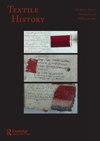时尚西班牙:从曼蒂利亚斯到罗萨利亚
IF 0.1
2区 社会学
0 HUMANITIES, MULTIDISCIPLINARY
引用次数: 0
摘要
西班牙时尚史,尤其是十六世纪至十九世纪之间的时尚史,已经得到了相对深入的研究。然而,二十世纪和二十一世纪的西班牙时尚并没有得到同样的关注,仍然需要作为一个研究领域加以发展。时尚西班牙:从曼蒂利亚斯到罗萨利亚,西班牙时尚界不仅从时尚史上,而且从广泛而异质的角度来看待这一时期,包括电影、摄影、音乐、地下运动和博物馆学等领域。这本由八篇文章组成的编辑卷分为四个部分。第一本《身份:政治与未来》由两本书组成:In es Corujo Martın的《访问国家:曼蒂拉斯、文化身份和现代西班牙》和Alberto Villamandos的《未来的身体:漫画、时尚和20世纪80年代的Movida》。两位作者都通过物品和媒介探索了这一时期的西班牙时尚,用曼蒂拉和漫画展示了这些媒介是如何表达近代史上流行的意识形态的。第二部分“描绘女性:电影与摄影”,由Kathleen M.Vernon的论文《女性、时尚与西班牙内战:从时尚游行到胜利游行》和Olga Sendra Ferrer的论文《从市场到女权主义:法国独裁时期的时尚摄影》组成。这两篇文章都谈到了将时尚作为一种工具来展示20世纪40年代、50年代和60年代西班牙女性的不同形象。第三部分,“设计时尚明星:电影和音乐”,包括文章“时尚西班牙电影明星:巴黎世家和黑山康奇塔”和“Rosalıa和Poligonera Chic的崛起”。在第一本书中,作家Jorge P erez解释了著名女演员Conchita Montenegro如何软化她20世纪30年代在好莱坞培养的蛇蝎美人形象,在20世纪40年代成为西班牙银幕上的明星,以及她的电影服装(部分由巴黎世家创作)是这一过程中的关键因素。Mary Kate Donovan在第二篇论文中解释了歌手Rosalıa的成功是如何促进poligono美学的普及的,以及Rosalşa如何巩固自己作为西班牙文化另一种地区时尚代表的地位。最后一节题为“博物馆:从壁橱到云端”,由胡安·古特雷斯的文章“特拉杰博物馆对西班牙波特的研究”和尼古拉斯·沃尔特斯的文章“通过加泰罗尼亚虚拟时尚博物馆的着装来策展加泰罗尼亚文化身份”组成。通过截然不同的案例研究,两位作者解释了近几十年来在博物馆领域开展的西班牙时尚工作,并强调了该领域仍有待解决的研究、保护和传播挑战。这本书是研究当代西班牙时尚的一个很好的起点,但鉴于不仅在本文章由计算机程序翻译,如有差异,请以英文原文为准。
Fashioning Spain: From Mantillas to Rosalía
The history of Spanish fashion, especially between the sixteenth and nineteenth centuries, has been studied in relative depth. However, Spanish fashion of the twentieth and twenty-first centuries has not received the same attention and still needs to be developed as a field of research. Fashioning Spain: From Mantillas to Rosal ıa approaches this period in Spanish fashion not just from fashion history, but from a broad and heterogeneous perspective including fields spanning cinema, photography, music, underground movements and museography. This edited volume of eight articles is divided into four parts. The first, ‘Identity: Politics and Futures’, comprises two texts: ‘Accessorizing the Nation: Mantillas, Cultural Identity, and Modern Spain’ by In es Corujo-Mart ın and ‘Bodies of the Future: Comics, Fashion and 1980s Movida’ by Alberto Villamandos. Both authors explore Spanish fashion of this period through objects and media, using the mantilla and comics to show how these mediums expressed prevailing ideologies in recent history. The second part, ‘Picturing Femininity: Film and Photography’, consists of the papers ‘Women, Fashion and the Spanish Civil War: From the Fashion Parade to the Victory Parade’ by Kathleen M. Vernon and ‘From Market to Feminism: Fashion Photography during the Franco Dictatorship’ by Olga Sendra Ferrer. Both texts address the use of fashion as a tool to project different images of women in Spain in the 1940s, ’50s and ’60s. The third section, ‘Designing Fashion Stars: Film and Music’, comprises the articles ‘Fashioning Spanish Film Stars: Balenciaga and Conchita Montenegro’ and ‘Rosal ıa and the Rise of Poligonera Chic’. In the first, author Jorge P erez explains how the renowned actress Conchita Montenegro had to soften the image of femme fatale she had cultivated in Hollywood in the 1930s, to become a star of the Spanish screen in the 1940s, and how the wardrobe of her films, partly created by Balenciaga, was a key element in this process. Mary Kate Donovan explains in the second paper how the success of the singer Rosal ıa has contributed to popularising the poligono aesthetic, and the ways in which Rosal ıa has consolidated herself as a representative of another regional fashion of Spanish culture. The last section, entitled ‘Museums: From Closets to the Cloud’, consists of the articles ‘The Museo del Traje’s Research on Spanish Prêta-Porter’ by Juan Guti errez and ‘Curating Catalan Cultural Identity through Dress in the Virtual Fashion Museum of Catalonia’ by Nicholas Wolters. Through very different case studies, both authors explain the work on Spanish fashion that has been carried out in the museum sphere in recent decades, and highlight the research, conservation and dissemination challenges still pending in this field. The book is a good point of departure for the study of contemporary Spanish fashion, but the contributors faced an ambitious and complex task given the labyrinth of political, economic and social changes that have occurred, not only in
求助全文
通过发布文献求助,成功后即可免费获取论文全文。
去求助
来源期刊

TEXTILE HISTORY
HUMANITIES, MULTIDISCIPLINARY-
CiteScore
1.00
自引率
0.00%
发文量
0
期刊介绍:
Textile History is an internationally recognised, peer reviewed journal and one of the leading publications in its field. It is viewed as an important outlet for current research. Published in the spring and autumn of each year, its remit has always been to facilitate the publication of high-quality research and discussion in all aspects of scholarship arising from the history of textiles and dress. Since its foundation the scope of the journal has been substantially expanded to include articles dealing with aspects of the cultural and social history of apparel and textiles, as well as issues arising from the exhibition, preservation and interpretation of historic textiles or clothing.
 求助内容:
求助内容: 应助结果提醒方式:
应助结果提醒方式:


